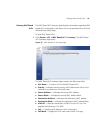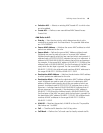
Defining Port-Based Authentication (802.1X) 61
■ Enable Guest VLAN — Provides limited network access to authorized
ports. If a port is denied network access via port-based authorization,
but the Guest VLAN is enabled, the port receives limited network
access. For example, a network administrator can use Guest VLANs to
deny network access via port-based authentication, but grant Internet
access to unauthorized users.
■ Guest VLAN ID — Specifies the guest VLAN ID.
802.1X Port Settings
■ Admin Port Control — Specifies the admin port authorization state.
■ Auto — Enables port based authentication on the device. The
interface moves between an authorized or unauthorized state
based on the authentication exchange between the device and the
client.
■ Force Authorized — Places the interface into an authorized state
without being authenticated. The interface re-sends and receives
normal traffic without client port based authentication.
■ Force Unauthorized — Denies the selected interface system access
by moving the interface into unauthorized state. The device cannot
provide authentication services to the client through the interface.
■ Guest VLAN — Specifies whether the Guest VLAN is enabled on the
port. The possible field values are:
■ Enable — Enables using a Guest VLAN for unauthorized ports. If a
Guest VLAN is enabled, the unauthorized port automatically joins
the VLAN selected from the Guest VLAN ID dropdown list.
■ Disable — Disables Guest VLAN on the port. This is the default.
■ Periodic Reauthentication — Enables periodic reauthentication on
the port.
■ Enable — Enables the periodic reauthentication on the port.
■ Disable — Disables the periodic reauthentication on the port.
■ Reauthentication Period — Defines the time span (in seconds) in
which the selected port is reauthenticated. The field default is 3600
seconds.
2 Define the fields.
3 Click . The 802.1X Settings are enabled, and the device is updated.


















